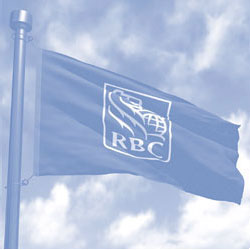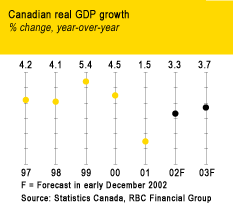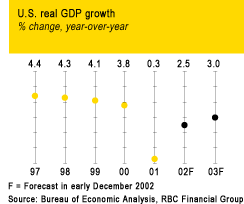
What credit risk management tools do you use to mitigate risk in your corporate loan portfolio?
Given the size of our balance sheet, credit risk is our largest source of risk. It is important to proactively manage our corporate loan portfolio, particularly during downturns in the economy. The goal of our credit risk management team is to evaluate and manage credit risk on an aggregate portfolio basis, and also to limit the risk associated with individual client defaults. We have been managing our loan portfolio over the past decade to lower our credit risk profile, and we have reduced our exposure as a percentage of common equity to any single company, industry or geographic area. Also, since the last economic downturn in 1991, business and government loans and acceptances have been reduced from 57 per cent of loans to 39 per cent at the end of 2002, while residential mortgages, whose loss ratios have been historically very low, have risen to 41 per cent from 27 per cent over that period.
Once credit has been extended, risk can be managed in several ways. Our portfolio is continuously managed through both periodic and event-related reviews of each borrower’s risk-reward profile and borrower rating. In situations where a borrower’s risk-reward profile is no longer desirable, we may use loan sales to remove the loan from our balance sheet, or we may choose not to renew the loan. We often participate in loan syndications which distribute the credit risk across a greater number of lenders. Risk is also mitigated through the use of instruments such as credit derivatives. We have purchased credit protection of approximately $1 billion on a number of higher risk accounts.
You are generating significant capital internally. How do you plan to deploy it?
In 2002, we generated $1.8 billion of capital internally (i.e., net income, less dividends paid on our common and preferred shares). We announced acquisitions totalling US$610 million and paid $764 million in connection with common share repurchases.
In deciding how to deploy our capital, we balance our need for strong capital ratios and high credit ratings against our desire to grow the business through accretive acquisitions and additional investment in our existing businesses, while enhancing returns through share repurchases and rewarding shareholders with higher dividends.
In 2003, we expect to continue to deploy our internal capital through a combination of share repurchases, reinvestment for growth, dividend payout and perhaps targeted U.S. acquisitions should they meet strategic, cultural and financial thresholds. As mentioned on page 8, our target dividend payout ratio has been raised from 30–40 per cent to 35–45 per cent.
What are you doing to maintain your strong market position in the Canadian retail banking sector?
Our Canadian personal and commercial banking business accounts for over 40 per cent of our total earnings. In Canada, we currently have number one or number two market shares in virtually all of our retail businesses – positions we are committed to retaining. In order to maintain our leadership, we plan to enhance our client service and recently announced that we will hire 450 salespeople for our branches by early 2003 and invest $35 million over 3 years to upgrade our branch network. In addition, our client segment strategies are designed to tailor our service offerings to meet specific segment needs, providing a differentiated experience for our clients. We will continue to manage each segment to increase client profitability and the number of products our clients hold with us.
We are also developing community banking initiatives to target underserved populations and to better serve the needs of particular communities. One such initiative, currently in a testing phase, is a new delivery channel called Cash & Save, which allows us to serve clients with their basic banking needs in a low-cost manner.
Finally, we believe that there is tremendous opportunity in the financial planning area, with RBC Banking and RBC Investments partnering to develop more proactive relationships with those clients who are looking for financial advice. Another priority is to capture a greater share of the wealth transfer between generations. The financial planning initiative will enable us to better retain and service our clients through their life cycle stages, leading to more revenue and greater client loyalty.
How are employees motivated to achieve your corporate and financial objectives?
We strongly believe that our people are vital to our success and our ability to achieve our corporate objectives. One of the key means of engaging employees is to provide reward and recognition when these goals are achieved.
We have a variety of compensation programs that reward individuals and teams for outstanding work. Employees participate in short-term performance-based incentive or commission-based programs that have a clear line of sight to our goals. By clearly connecting personal performance and corporate objectives, individual employees can see the link to our bottom line. The annual short-term bonus paid is determined by a combination of individual performance, business unit performance and performance against our overall corporate objectives. In addition, senior management and most other employees are shareholders, reinforcing the strong alignment between employee and shareholder interests.
When it comes to motivating employees to achieve top performance, given the diversity of our employees, business cultures and the markets we serve, we recognize that one size does not fit all. As a result, we have developed a Total Rewards approach that focuses on the four cornerstones of employee engagement: competitive pay, comprehensive benefit programs, opportunity for career development, and a high-performance and motivating work environment. This approach is enhancing our ability to attract, engage and retain employees as partners in our future success.
To what do you attribute the relative stability of your trading-related revenues?
We attribute our consistent performance to a number of factors, including the diversification and composition of our trading book and a conservative trading strategy that is reflected in a low Value-At-Risk and a low number of days of net trading losses. In general, our trading revenues are the result of earning competitive spreads on trading volumes rather than taking substantial proprietary positions.
Execution of this strategy provided higher revenues in equities and in the interest rate and credit-related products of the fixed income business. However, we had lower revenues in foreign exchange and money markets, due largely to lower trading volumes.
What is your economic outlook for North America for 2003?
Our economic outlook for the coming year is one of cautious optimism. A high degree of uncertainty associated with financial market turbulence, the global growth outlook and international conflict remains in place heading into 2003. That said, however, we suspect this uncertainty will gradually ebb as we move forward, paving the way for a return to stronger growth.
In Canada, tentative signs of resurgence in the corporate sector have already emerged. Job creation has been strong. Companies have increased their stock of inventories and production. Even business investment has risen, albeit modestly and unevenly, alongside a jump in profits.
Key to Canada’s improving growth prospects have been a low interest rate environment and an undervalued currency. Both will continue to exert positive effects into 2003 even as they begin to reverse course with an expected increase in inflation.
Upward price pressures, which pushed core consumer price inflation to 2.5 per cent in the fall of 2002, are likely to intensify and push core consumer inflation to the upper limit of the Bank of Canada’s inflation target band of 1-3 per cent. The central bank has already responded by hiking interest rates three times in 2002 – for a total increase of 75 basis points – only pausing late in the year as external factors put the world, and, more particularly, the U.S., economic outlook at risk.
North American prospects in 2003 depend on a turnaround in the U.S. business sector. Consumers kept the U.S. economy afloat in 2002, but will be hard-pressed to offer a repeat performance. Generational lows in interest rates induced consumers to bring forward some spending, partially satiating the appetite for durables goods, such as motor vehicles and home furnishings, in the period ahead. A low interest rate environment should prove supportive again in 2003 for consumers, but having dug into future demand, any upside to consumer spending should be limited.
Business investment and production, which began to rise earlier in 2002 alongside consumer spending, tapered off in the second half of the year as consumer, business and investor confidence sagged. Should confidence improve, however, the outlook for businesses is positive. Business inventories are low relative to sales, and profits – supported by strong productivity growth – are increasing and expected to keep increasing, although moderately, in 2003. Following a year of nearly no job growth, stalling business investment and production, 2003 should bring some welcome and much needed relief.
Not withstanding downside risks arising from confidence, the U.S. economy is expected to expand by 3.0 per cent in 2003 after growing an anticipated 2.5 per cent in 2002. Canada’s economy, being a little farther along in the growth cycle, is forecast to expand by 3.7 per cent in 2003 following an expected gain of 3.3 per cent in 2002. With business cycles slightly out of sync, the Bank of Canada may have to be somewhat more pre-emptive than the U.S. Federal Reserve at tightening monetary conditions. More interest rate hikes are expected in Canada in 2003 in a bid to keep inflation within the central bank’s target band, the bulk of which are expected to come in the latter half of the year. Given the lack of inflation concerns in the U.S., we anticipate the Federal Reserve will raise rates – but by a lesser amount – starting in the fall of 2003.
 |  |